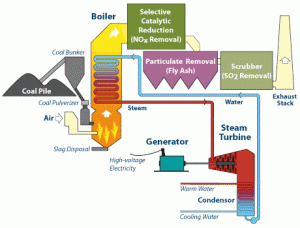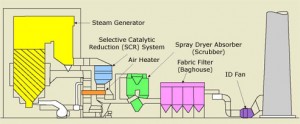Nov
13
Ultra Supercritical Steam Generation
November 13, 2008 | 15 Comments
We might want to know what this is, its going to affect your electricity rates. Ultra supercritical (USC) steam generation is a derivation on the definitions of the temperature and pressure at which water vapor and liquid water are indistinguishable, aka the “Critical Point.” At that critical point of water some 705 degrees F/3208 psi, the bubbles of boiling disappears and the adding of heat or pressure to the basic water pushes a transition from water like to steam like characteristics.
Pressure in a steam boiler is said to be “supercritical” when the pressure exceeds 3208 psi. A conventional supercritical unit operates at a steam pressure of 3500 psi or higher and steam temperatures of 1000 –1050F. By contrast, a subcritical unit operates below the critical pressure, typically 2400 psi at similar temperatures.
The point of this is to save on coal to heat the water and reduce CO2 emissions. The gain in turbine efficiency is such that the added energy to reach higher temperatures can be recovered; at least in part so that the emissions can be reduced without hopefully, driving electricity rates out of sight.
The difference lies in using pressure. We are familiar with the conventional sub-critical steam generation unit, the system operating at pressures that convert water to steam through the process of boiling. Now at supercritical pressures, water is heated to produce steam through a gradual expansion without boiling. Due to improved thermodynamics of expanding higher pressure and temperature steam through the turbine, a supercritical steam-generating unit is more efficient than a sub-critical unit.
Efficiencies get up to the 39 percent range. USC technology means that electricity can be produced using less fuel. Because less coal is consumed, emissions of sulfur dioxide (SO2), nitrogen oxide (NOx), mercury (Hg), carbon dioxide (CO2) and particulate and solid waste byproducts are reduced. And USC technology is compatible with all types of coal.
Early supercritical units initially operated at ultra supercritical levels. However, due to the unavailability of metals that could tolerate these high temperatures for extended periods of time, operation at these levels could not be sustained. Now power plants can be built using the recently developed chrome and nickel-based super alloys in components of the steam generator, turbine and piping systems that are exposed to the higher temperatures. The new metals can perform under these prolonged operating conditions, rendering USC no longer a goal, but practical design basis.
Southwestern Electric uses this example to pitch their new USC plant: a 600 megawatt USC unit burning a typical Powder River Basin coal would consume 2.0 million fewer tons of coal over its lifetime than a comparably sized supercritical unit at steam temperatures of 1000°F. Again comparing these same two units, a three percent improvement in the heat rate (a measure of the fuel consumed to produce a unit of electric energy) would reduce CO2 emissions by nearly 4 million tons over a 30-year period.
While USC is not a big percentage saving, the influence from environmental desires to reduce CO2 makes for changed economics. The added expense is sure to get to ratepayers, but it looks as though the costs are not nearly as scary as some ideas on carbon trading and other schemes to get carbon out of energy systems would be. In any case that 39% efficiency rating is a great advantage both in raw power production and downstream use such as charging electric vehicles.
On the emissions front USC offers as good or better performance on the emissions that matter like particulates, metals as in mercury, volatile organics, and sulfur. Over time a continuous upgrade in coal burners may be transitional to more biomass as a fuel. With the heating units and turbine sets already in place the biomass fuel market could get big quickly if the genetics and production costs get competitive with coal. We’ll be looking into that, later.
Ultra supercritical is worth knowing and understanding. It’s sure to be around until some form of fusion takes off in a big way.
Comments
15 Comments so far





There is nice explaination of super critical boilers. I could clear concept of supercritical.
thanks®ards
kdpandey
Nice information. Thanks so much, I absolutely enjoy reading your post.
nice post. thanks.
To the point and written well, tyvm for that info.
There is nice information that adout supercritical condition of water. Please reform our information.Thanks
Interesting read, perhaps the best article iv’e browse today. We learn everyday cheers to you!
Can someone tell me who was invented the Ultra supercritical (USC) steam technology?
If we want adopt this technology, where and who we should contact?
Many Thanks
Nice post! You truly have a wonderful way of writing which I find captivating! I will definitely be bookmarking you and returning to your blog. In fact, your post reminded me about a strange thing that happened to me the other day. I’ll tell you about that later…
I REALLY liked your post and blog! It took me a minute bit to find your site…but I bookmarked it. Would you mind if I posted a link back to your post?
can you please email me how the tubes inside the boiler are arenged
what the efficiency of the super critical power station arrive
[…] it possible they’ll start building new supercritical and ultracritical plants? It’s just possible, but I don’t think it’s very likely. It’s more […]
Could somebody show the comparation of sub crtical, supercritical and ultra supercritical steam boiler in combustion effisiency, in co2 emission, NOx emision, SO2 and Hg emission ? how about the production of fly ash ? assuming all the steam generator use the same coal.
Hallo..
I want to know if a 1000mw supercritical steam generator can be powered by electricity and if so how much power will be needed to power it for 24hrs.Thanks